
The long-nosed snake is a species of nonvenomous snake in the family Colubridae. The species is endemic to North America. It has two recognized subspecies. The other species in the genus were previously considered subspecies.

Tantilla is a large genus of harmless New World snakes in the family Colubridae. The genus includes 66 species, which are commonly known as centipede snakes, black-headed snakes, and flathead snakes.
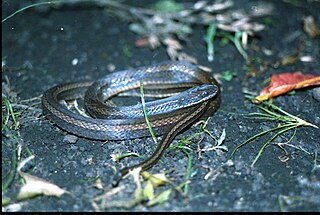
Coniophanes is a genus of colubrid snakes, commonly referred to as black-striped snakes, but they also have many other common names. The genus consists of 17 species, and despite the common name, not all of them display striping.
The Saint Croix racer is a possibly extinct species of snake in the family Colubridae that is endemic to the island of Saint Croix in the United States Virgin Islands.

Thamnophis copei, Cope's mountain meadow snake, is a vulnerable species of snake in the family Colubridae. The species was originally described by Alfredo Dugès in 1897, and is endemic to Mexico. It is the type species of the genus AdelophisDugès, 1879.
Shaw's dark ground snake, also known commonly as Shaw's black-backed snake, and in Spanish as candelilla, guarda caminos, and reinita cazadora, is a species of snake in the family Colubridae. The species is native to northern South America.

Geophis sanniolus, commonly known as the pygmy snail-eating snake or the pygmy snail sucker, is a species of small snake in the family Colubridae. The species is endemic to Central America and southeastern Mexico.
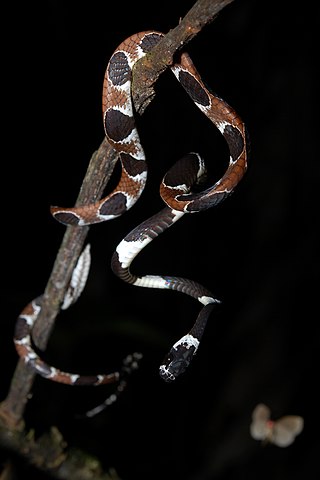
Catesby's snail-eater, also commonly known as Catesby's snail sucker, is a nocturnal species of nonvenomous snake in the family Colubridae. The species is native to northern South America.
Amastridium is a genus of snakes in the family Colubridae. The genus is endemic to Mexico, Central America and Colombia.

Imantodes is a genus of colubrid snakes commonly referred to as blunt-headed vine snakes or blunt-headed tree snakes. The genus consists of seven species that are native to Mexico, Central America, and the northern part of South America.

Xenopholis scalaris, Wucherer's ground snake, is a species of snake in the family Colubridae. The species is endemic to South America.
The West Coast garter snake is a species of snake in the family Colubridae. The species is endemic to Mexico. Four subspecies are recognized.
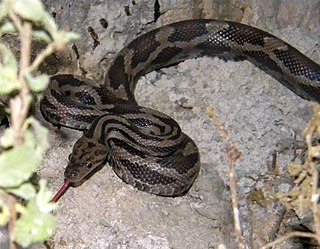
The yellow-red rat snake is a species of snake in the family Colubridae. The species is endemic to Mexico and Central America. Three subspecies are recognized.
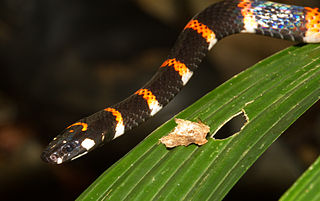
Pliocercus euryzonus, commonly known as Cope's false coral snake, is a species of snake in the subfamily Dipsadinae of the family Colubridae. The species is indigenous to southeastern Central America and northwestern South America. There are two recognized subspecies.

Ialtris is a genus of snakes in the subfamily Dipsadinae of the family Colubridae. The genus is endemic to the island of Hispaniola.

The Colombian longtail snake, also known commonly as the sock-headed snake and the white-headed snake, is a species of snake in the family Colubridae. The species, which is monotypic in the genus Enuliophis, is native to Central America and northern South America.
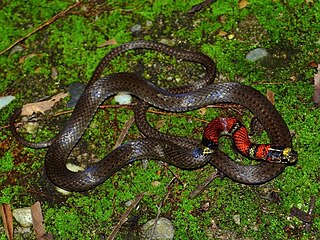
Scaphiodontophis annulatus, commonly known as the Guatemala neckband snake, is a species of snake in the family Colubridae. The species is native to southern Mexico, Central America, and Colombia. There are four recognized subspecies.

Pituophis lineaticollis, commonly known as the Middle American gopher snake or the cincuate bull snake, is a species of nonvenomous snake in the family Colubridae. The species is native to Guatemala and southeastern Mexico. There are two recognized subspecies.
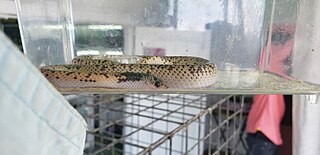
Phimophis guianensis, also known commonly as Troschel's pampas snake, is a species of snake in the subfamily Dipsadinae of the family Colubridae. The species is endemic to South America.
Pliocercus elapoides, also known commonly as the variegated false coral snake, is a species of snake in the family Colubridae. The species is native to southern North America and northern Central America. There are four recognized subspecies.
















